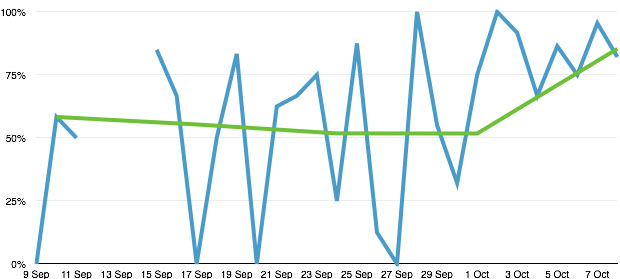The signal and the noise

...for small transactions. We're going to switch to weekly averages for several metrics to make the trend clearer. Here's a graph of user satisfaction for Prison visit bookings, showing daily...

...for small transactions. We're going to switch to weekly averages for several metrics to make the trend clearer. Here's a graph of user satisfaction for Prison visit bookings, showing daily...

...helped the team optimise this trade-off. Now the FSA is looking at other potential use cases for this type of analysis. Meanwhile the Foreign and Commonwealth Office (FCO) is experimenting...
...all paid intermediaries). Visual design The standard of design is high and consistent with GOV.UK patterns. Recommendations Reliance on the tax platform For the beta assessment the assessment panel would...

...journey – things like learn to drive and protect your intellectual property. User journey for Learn to drive We've made a prototype dashboard for the service 'learn to drive'. This...
The SCS 360 Appraisal Tool service is seeking permission for Beta Assessment approval. Department / Agency: MOJ Date of Assessment: 17/12/2014 Assessment stage: Beta Review Result of Assessment: Pass Lead...
...6 key data points for each dashboard and overview statistics for those selected in the filter. New services page Our ambition with this page was to provide more information...
...to create something to try and show it. This Performance Platform dashboard is the outcome. Not everyone knows that our team manages many things. For example, we're responsible for the...

...pieces of information and this formed the first version of our performance platform dashboard. For the data that lived in our own back end database, we were given templates by...
Since March 2015 a small, multidisciplinary team has been reassessing our understanding of users and the needs for the service design manual. Here's an introduction to what the team is...
...a good score if many people registered online to vote. It would be better to measure what proportion of transactions are online (or how many paper forms citizens still have...